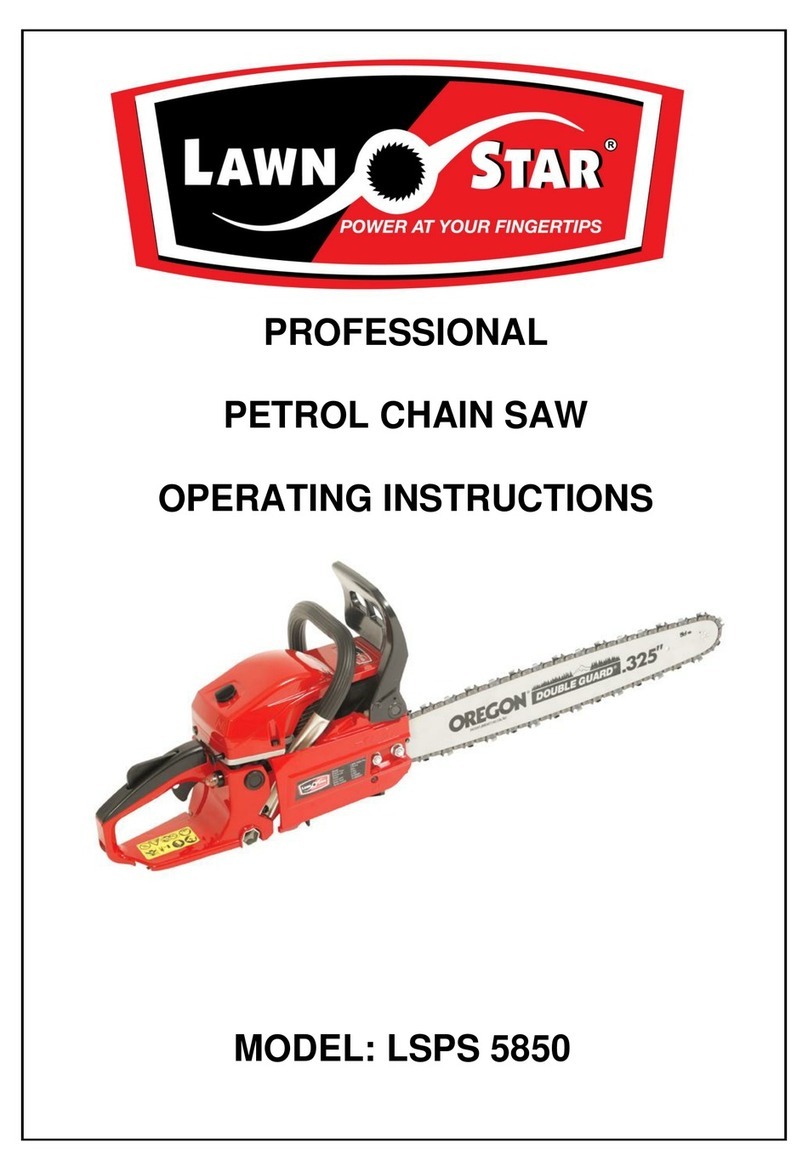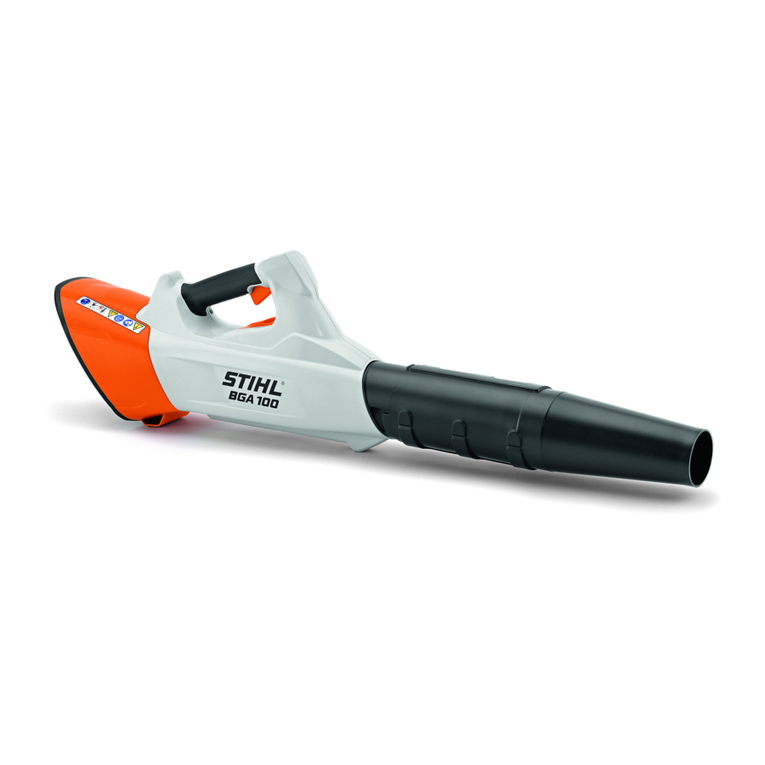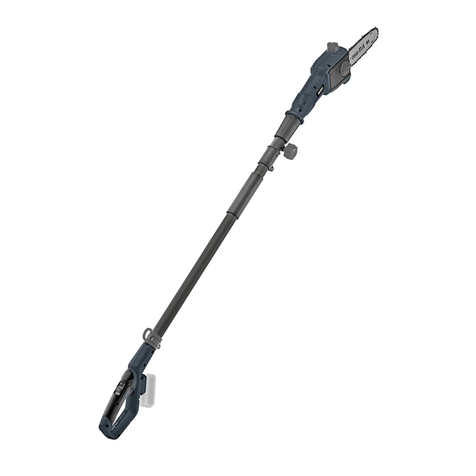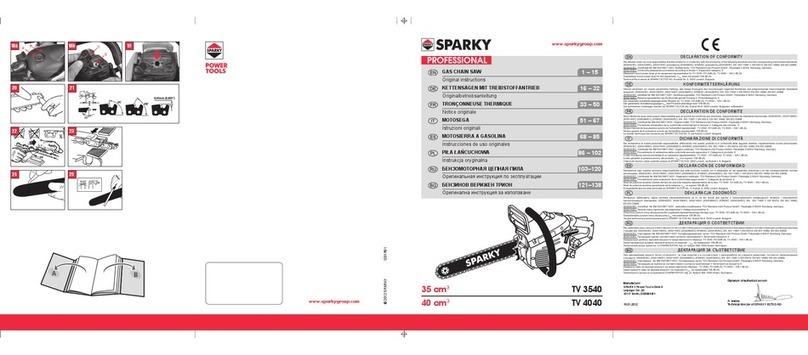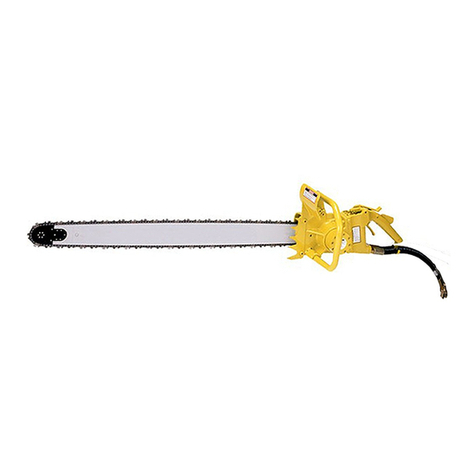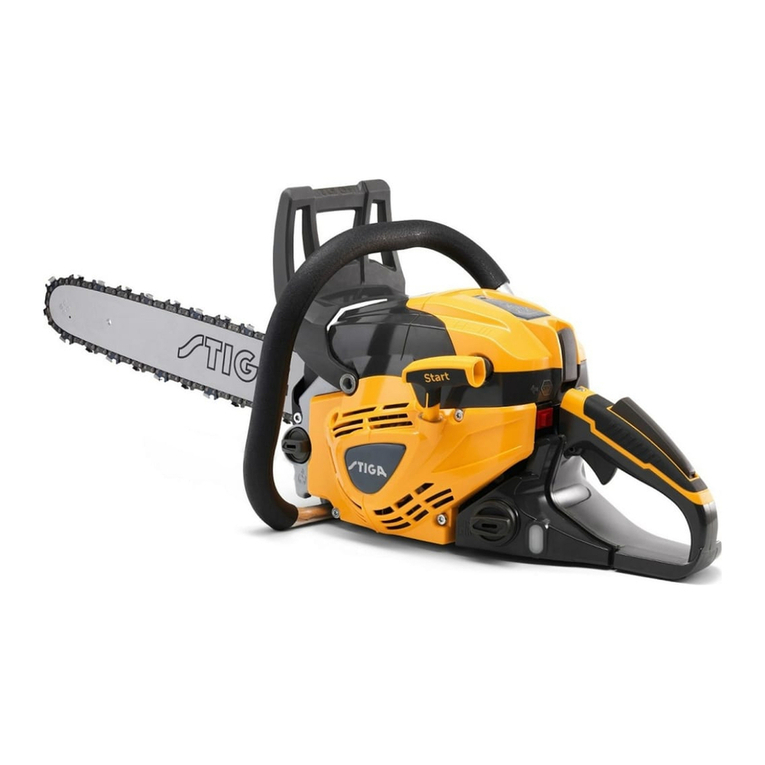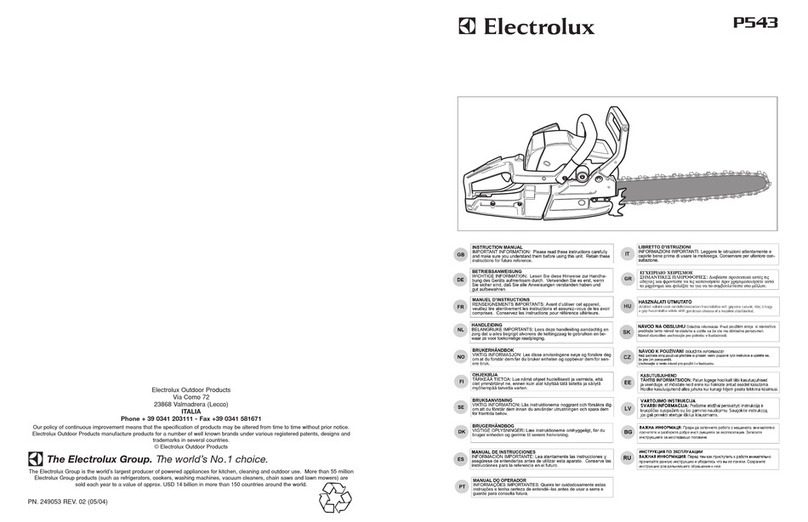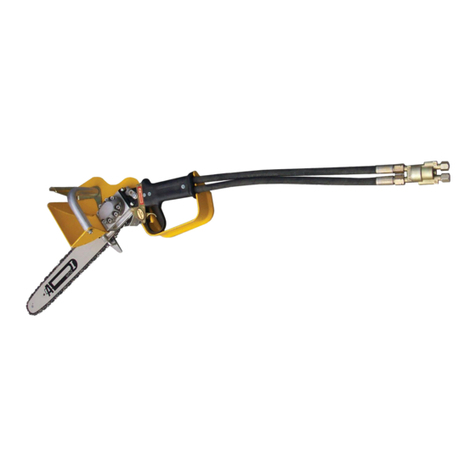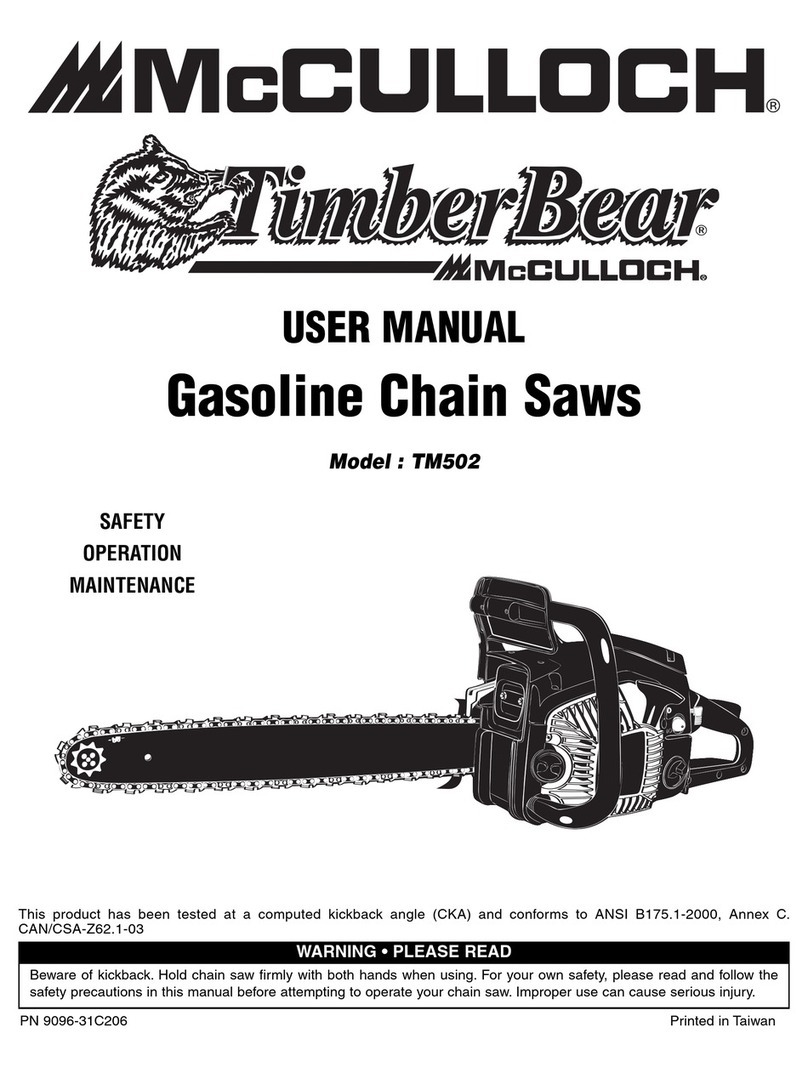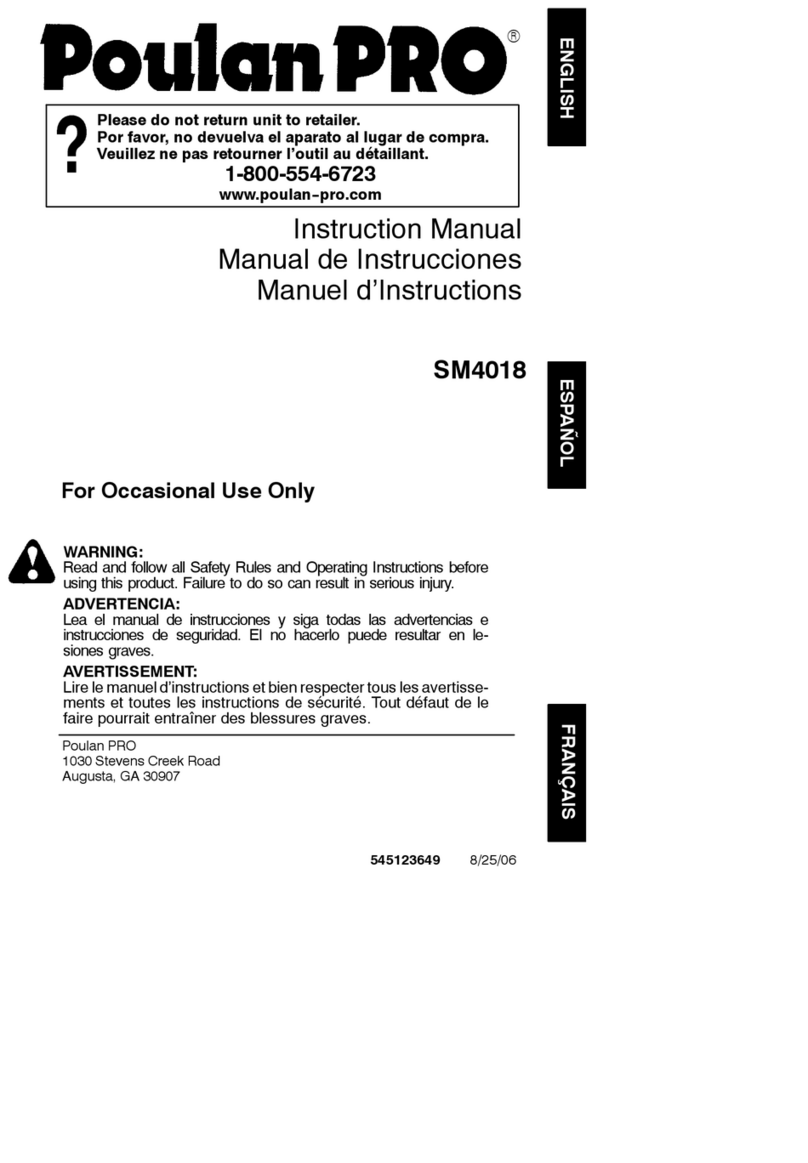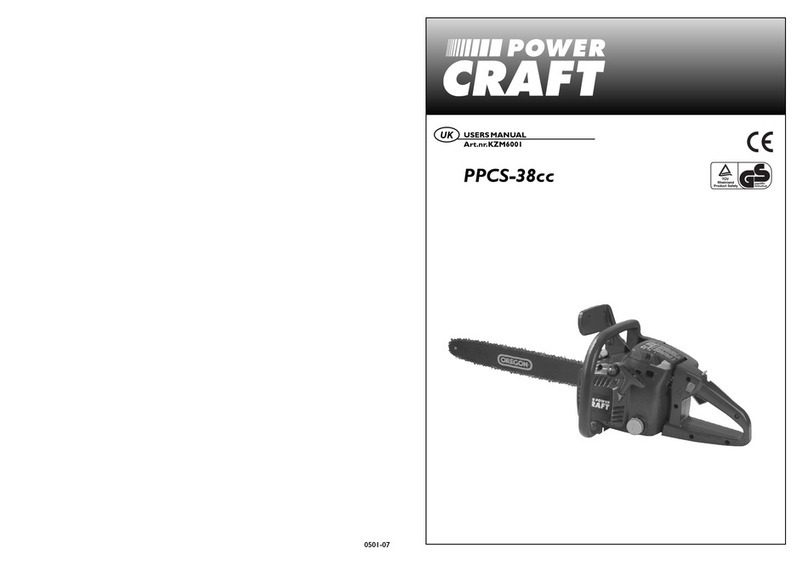LAWN STAR LSS 2035 User manual

ELECTRIC CHAINSAW
OPERATING INSTRUCTIONS
MODEL: LSS 2035

2
Thank you for purchasing the Lawn Star Chainsaw which is one of the finest and most
advanced chainsaws today’s technology can produce. Before you begin using it, please
read this manual carefully and familiarise yourself with the control and the proper use of
this product to ensure you get the best possible performance from it.
IMPORTANT INSTRUCTIONS FOR YOUR PERSONAL SAFETY
Before using the chainsaw, read the operating instructions and act accordingly.
ATTENTION: You run the risk of injury if you use the chainsaw incorrectly. It is
imperative that you read these Operating Instructions and follow the instructions given.
We recommend that first-time users must obtain practical training in the correct use of
the chainsaw and the required safety equipment from an experienced operator.
A) General safety instructions
Caution!: When electric tools are being used, the following basic safety measures
must be observed to prevent electric shock, injury and risk of fire.
Protect yourself against electric shock. Avoid body contact with grounded elements
e.g. pipes radiators, stoves, refrigerators.
Do not allow children less than 18 years of age, nor anyone who is not familiar with
these instructions to use the chainsaw.
The chainsaw should be used by trained and experienced persons only.
Keep the operating instructions together with the chainsaw for future reference.
Do not operate this chainsaw when tired, ill, or under the influence of alcohol, drugs or
medication.
Only operate the chainsaw if physically fit and alert.
Obey all safety instructions and warnings.
Ensure that children and other spectators are kept a safe distance from the working
area.
B) Instructions on the proper use of personal protective clothing
Working with a chainsaw requires special measures with regard to protective
equipment and clothing suitable for protecting your head, hands, feet, legs, eyes and
ears.
Keep body parts away from the chain.
Do not wear loose fitting clothing which can get caught in moving parts.
Always wear an approved safety helmet when felling trees and removing branches.
Always wear safety goggles and/or a face guard.
Always wear suitable protective gloves.
Wear ear protection to avoid damage to your hearing.
Wear safety clothing including sturdy, non-slip footwear.
Wear leg guards.
C) Instructions on the safe use of the chainsaw
ATTENTION: Read the operating instructions carefully and familiarise
yourself in the correct use of the chainsaw before using it for the first time.
Use only genuine Lawn Star (Pty) Ltd. replacement parts when servicing or repairing
the unit. These parts are listed in the operating instructions and are available from
your supplying dealer or service agent.
Repairs may only be performed by authorised service agents.

3
Never carry or suspend the chainsaw by the electrical supply cable. Do not use the
cable to pull the plug from the socket. Protect the cable from heat, oil and sharp
edges.
Check the extension cable and supply cable before every use and replace it if worn or
damaged. Keep the handles dry and free of oil and grease.
Remove the plug from the socket when replacing the chain or bar.
Avoid accidental starting. Do not hold your finger on the switch when carrying the
chainsaw when it is connected to the power source. Ensure that the switch is off
before inserting the plug into the socket.
Damaged switches must be replaced by an authorised service agent. Do not use the
chainsaw if the switch is faulty.
Avoid dangerous environments. Do not use the unit in poor light or in damp or wet
locations. Do not use in the rain. Do not over-reach. Ensure good footing and balance
are maintained.
Check the chainsaw for damage before every use. Pay special attention to the chain-
bar and chain. If any part is damaged or worn, repair or replace before operation.
Always hold the chainsaw firmly with both hands while working with it.
No other person may be within the working range of the chainsaw.
The chainsaw must be disconnected from the power supply before adjusting the chain
tension, exchanging the chain or carrying out any maintenance or repair on it.
Disconnect from the plug!
When not in use put the chainsaw down in such a manner that there is no risk of
injury.
Always use the chain bar cover when transporting the chainsaw.
When switching on the chainsaw, ensure that you hold it firmly with both hands. The
chain and bar must be free.
Before starting work ensure good footing.
Disconnect the plug immediately should the power cable be damaged or cut.
Never cut with the tip of the bar –the chainsaw may recoil (“kick-back”)
Do not use the chainsaw near combustible gases or dust –danger of explosion.
The chainsaw may only be connected to socket outlets which are protected by a
Residual Current Device (RCD) with a tripping current of not more than 30 mA.
Fully unwind the extension cable before use.
The chainsaw may only be used with all safety guards and features completely
assembled. Ensure all screws and nuts are properly tightened before use.
Switch the chainsaw off immediately if you notice any changes in the machine.
Always have a first-aid kit at hand in case of accidents.
If the chain comes into contact with soil, stones, nails or other foreign objects, stop
the chainsaw immediately and check the chain as well as the bar.
Never leave the chainsaw unsupervised.
Ensure that no chain oil penetrates into the soil or sewage. Always place the
chainsaw on something that will absorb any oil dripping from the bar or chain.
Switch off the chainsaw immediately if it becomes blocked. Visually inspect the
chainsaw for damage. Note, if the chainsaw is damaged, repairs and servicing must
only be performed by authorised dealers and service agents.
Never remove any of its components and never use a damaged or incomplete
machine. Never modify any of the machine components. DO NOT fasten tools or
accessories to the chainsaw that are not specified by the chainsaw manufacturer.
Do not use your chainsaw for any jobs other than those for which it was intended.
ATTENTION: Safety features are designed to protect you against injuries and must
not be altered or circumvented.

4
D) Warning: Danger of recoil (“kickback”)
WARNING: Kickback may occur when the motor is running and the nose
or tip of the guide bar touches an object, or when the wood closes in and
pinches the saw chain in the cut. Top contact in some cases may cause a
lightning fast reverse reaction, kicking the guide bar up and back towards
the operator. Pinching the saw chain along the top of the guide bar may
push the guide bar rapidly back towards the operator. Either of these
reactions may cause the operator to lose control of the saw which could
result in the chainsaw being flung upwards at high speed towards the
person holding the chainsaw and may cause serious personal injury.
Do not rely exclusively on the safety devices built into your saw. As a chainsaw user
you should take several steps to keep cutting jobs free from accident or injury.
With a basic understanding of kickback you can reduce or eliminate the element of
surprise. Sudden surprise contributes to accidents:
1. Do not touch wood, branches or any other obstruction with the chain bar tip.
2. If possible, use a log stand for cutting loose logs.
3. Always be aware of the bar tip in relation to other objects.
4. Begin cutting only once the chainsaw is at operating speed. Never start the
machine while the chain rests on an object.
5. Piercing cuts with the bar tip may only be performed by trained and
experienced operators.
6. Keep a good grip on the saw with both hands, the right hand on the rear
handle, and the left hand on the front handle, when the motor is running. Use a
firm grip with thumbs and fingers encircling the chainsaw handles. A firm grip
will help you reduce kickback and maintain control of the saw.
7. Make certain that the area in which you are cutting is free from obstructions.
8. Do not overreach or cut above shoulder height.
9. Ensure the chain is always sharp. Follow the manufacturers maintenance
instructions for saw chain.
10.Only use replacement bars and chains specified by the manufacturer or the
equivalent.
E) Instructions on safe working techniques
Before starting to work ensure that there is sufficient light.
Always maintain a normal body posture when operating the device. Always keep your
balance.
Do not work with your body bent forwards.
Ensure that you are standing securely and do not work on snow, ice or newly barked
wood. Danger of slipping!
Do not work on ladders, scaffolding, or walls. Never climb on a tree to cut wood.
Do not use the chainsaw above shoulder height.
Use the chainsaw only to cut wood. Do not cut plastics or other material.
Ensure that the wood cannot twist while it is being cut.
Watch out for splintering wood. While you are sawing you may be injured by flying
wood chips.
Do not use the chainsaw to lever or move the wood.
Only cut with the lower section of the saw. The saw will be repulsed towards you if
you try and cut with the upper section of the saw.
Ensure that the wood is free from of stones, nails and other foreign objects.
Keep the running chainsaw from touching the ground or wire fences. Do not cut thin
wood or timber that is already sawn into small pieces.

5
The following symbols appear on the chain saw. For safe operation and
maintenance, please know what the symbols mean:
Chain direction:
Symbol of chain and arrows show which direction to
assemble the chain on the chain bar and machine.
Tighten chain bar with SDS knob
Loosen chain bar with SDS knob
Minimum chain oil level
Chain Brake:(only appears on certain models)
Arrows show which direction to engage or disengage chain
brake. Push the guard all the way forward to engage, and
pull back to disengage.
OIL min
Warning Symbols
Read operating
instructions before
operating this machine
Warning: Kick-back
Remove plug from the
mains immediately if the
cable is damaged or cut.
Wear head, eye and ear
protection
Keep bystanders away
from chain saw when it is
in use
Do not use in rain
Hold the chain saw with
both hands when
operating.
Warning!
Wear safety gloves
Wearing of protective
shoes advised
!

6
ASSEMBLY OF CHAINSAW
Your chainsaw package contains the following items as illustrated in figure 1.
Assembling the guide bar and the saw chain:
CAUTION: The saw chain has very sharp edges. Always use safety gloves when assembling
the chain.
Assembly of the guide bar and chain does not require any tools.
1. Ensure the chainsaw is unplugged from the mains supply.
2. Place the chainsaw on a stable surface.
3. Pull the guard towards the front handle to check that the chain brake is off (Fig.2).
4. Loosen the chain cover nut (Fig.3) by turning it anti-clockwise and remove the chain cover.
5. Place the chain on the bar (Fig.4) considering the running direction of the chain. The cutting
teeth on the upper side of the bar must point in the forward direction (Fig.4).
3
12
5
6
1. Rear handle
2. Oil tank cap
3. Front handle
4. Front finger guard /
chain brake
5. Chain bar
6. Saw chain
7. Chain cover nut
8. Cover
9. Switch
10. Cable strain-relief hook
11. Power cable
12. Chain-bar protector
13. Chain lube level
indicator
Figure 1
1
4
7
8
9
13
10
2
11
Fig.2
Fig.3
Fig.4

7
6. Rotate the chain tensioning screw anti-clockwise (Fig.5)to move the tensioning lug to the
rear half of the slot.
7. Assemble bar and chain onto chainsaw and check that all chain links are seated correctly in
the bar’s groove and that the chain is correctly fitted around the driving sprocket (Fig.6).
8. Replace the cover and lightly fasten the cover by turning chain cover nut clockwise (Fig.7).
9. Adjust the chain tension until ¾ of the tooth can be seen when pulling the chain by hand
(Fig.8). The the chain tension is adjusted by rotating chain tensioning screw clockwise
(Fig.9) . When the correct tension is achieved fully tighten the chain cover nut by rotating it
clockwise (Fig.7).
Note: The chainsaw must never be operated without chain oil as this will cause damage to the
chain, bar, and motor. No claims under warranty can be accepted if damage occurs due to the
chainsaw being operated without chain oil.
Tensioning the chain:
Note: before you start tensioning the chain:
Make sure that all the chain links are seated inside the groove of the guide bar.
The chain cover nut (Fig.1 No.7) may need to be loosened slightly to allow the
guide bar to be adjusted.
1. Tension the chain by rotating chain tensioning screw clockwise (Fig.9).
2. Make sure you don’t tension the chain too tightly. When cold, it should be possible to lift the
chain in the middle of the guide bar approximately 3-5 mm (Fig.8). To decrease the chain
tension, turn the chain tensioning screw anti-clockwise.
Fig.5
Fig.6
Fig.7
Fig.8
Fig.9

8
3. Once the correct chain tension is achieved, ensure the chain cover nut is fully fastened by
turning clockwise.
4. If necessary, readjust the tension of the chain by first loosening the chain cover, then again
adjusting the chain tension by turning the chain tensioning screw. Securely retighten the
chain cover agai.
A new chainsaw requires a running-in period of approximately 5 minutes. Chain
lubrication is very important during the running-in period. After running-in, check
tension and re-tension if necessary. The chain must be re-tensioned immediately if
it shakes or leaves the groove.
NOTE: The chain tension has a significant effect on the life of the chainsaw, and must therefore
be checked regularly. Check and readjust the tension frequently as a loose chain can easily
derail or cause rapid wear of itself and the guide bar. When the chain warms up to operating
temperature it will expand a little and must be re-tensioned. A new chain will have to be
tensioned more frequently.
If the saw chain is re-tensioned when hot, it must be loosened again when the sawing work has
been completed. Otherwise the contraction, which takes place when the chain cools off, will
result in excessively high tension.
Figure 10

9
Chain
brake OFF
(operating
position)
Chain
brake ON
Figure 12
Figure 11
Bar
groove
Oiling
port
Grease
port
Figure 13
Lock-off
button
On
switch

10
FILLING THE OIL TANK (FIG.1 NO.2)
The chainsaw must never be operated without chain oil as this will cause damage to the
chain, bar, and motor. No claims under warranty can be accepted if damage occurs due to
the chainsaw being operated without chain oil.
Preferably use biologically-based chainsaw oil such as Lawn Star chain lube stock code
90-30000, i.e. oil which is biologically decomposable. NOTE: Do not use waste or recycled
oil that can cause damage to the oil pump.
Before filling the oil tank, remove the mains plug.
Unscrew the cap (Fig.1 No.2) and fill approximately 200ml oil into the tank using a funnel
and replace the cap securely.
The oil level can be seen through the oil indicator window (Fig.1 No15).
Remove the chain oil from the oil tank if the chainsaw is not used for a long period.
The oil tank should be emptied before the chainsaw is transported.
After use, lay the chainsaw horizontally on an absorbent surface.
BEFORE USING THE CHAINSAW
Before proceeding to your job, read “IMPORTANT INSTRUCTIONS FOR YOUR
PERSONAL SAFETY” section.
Always follow the safety procedures and guidelines.
Check chainsaw for damage before starting work.
Ensure that the chain tension is correct. If the chain is too loose, it may come off during use
and lead to injuries. The chain must be replaced immediately if it is damaged.
Check the sharpness of the chain every time before using the chainsaw. A new chain must
be used if the chain is blunt.
It is recommended to first practice sawing on smaller easier-to-cut logs. This helps to get
accustomed to the chainsaw.
CONNECTING THE CHAINSAW TO POWER (Fig.3)
To prevent electrical shock hazards, use only extension cables suitable for
outdoor use, with splash-proof socket outlets, preferably protected by sensitive
Residual Current Device (RCD) with tripping current of not more than 30 mA. Use
2-core insulated cable, minimum (HO5VV-F) 2x1.0mm, in turn connected to a
suitable mains connection plug. All components should meet your national, IEC or
EN specifications. If the connection cable of this device is damaged it must be
replaced by an authorised service agent specified by the manufacturer.
This chainsaw is fitted with a strain-relief mechanism to provide extra safety and to prevent
accidental disconnection. First connect the supply plug to the extension cable, then double over
the extension cable into a loop and push this through the cable restraint. Hook the loop into the
strain-relief mechanism on the underside of the handle as shown in Figure 10.
SWITCHING ON
Using your thumb press in the “Lock-off” button (Fig.12) situated on the left side of the handle,
then activate the switch.
To switch off the chainsaw, release the switch.
Attention: The chain will immediately run at high speed when switched on. When
putting the saw down, make sure that the chain does not touch any stones, soil or
metal objects.

11
SAFETY DEVICES ON THE CHAINSAW
CHAIN BRAKE (Fig.11)
This chainsaw is equipped with a mechanical safety chain brake. Should the tip of the saw
blade make contact with the object being cut or any other solid object, the chainsaw may recoil
(“kick-back”). In the event of kickback, the chain brake guard (Fig.11) will be activated by the
back of the operators hand and the saw chain will be stopped.
CAUTION: The motor must be switched off before the chain brake is released. To
release the chain brake, pull the brake guard back in the direction of the handle
until locked in position with a “click” sound.
The brake will only be activated if operating the chainsaw correctly.
Always insure that the chain brake guard is locked into the operating position (Fig.2)
before starting the chainsaw.
Check the chain brake operation before each usage by running the chainsaw for 1-2
seconds and pushing the front hand guard forward. The chain should stop immediately with
the motor at full speed. If the chain is slow to stop or does not stop, have the brake band and
clutch drum replaced or serviced before using the chainsaw.
It is extremely important that the chain brake be checked for proper operation
before each use and that the chain is sharp. Removal of the safety devices,
inadequate maintenance, or incorrect replacement of the bar or chain may
increase the risk of serious personal injury due to kickback.
CHAIN CATCH BOLT
The chainsaw is fitted with a chain catch bolt. Should the chain break when the saw is in use,
the chain bolt will catch the loose chain end and thus prevent injury to the operator’s hand.
Figure 15
Figure 14
Oil spray from
chain
3
1
2

12
OPERATING INSTRUCTIONS
BEFORE STARTING MOTOR
Check the working area, the wood to be cut and cutting direction. If there is an obstacle,
remove it.
Ensure you have a clear working area, secure footing and a planned retreat path from falling
timber
Inspect the machine for worn, loose, or damaged parts. Never operate the machine that is
damaged, improperly adjusted, or is not completely and securely assembled.
WHEN STARTING THE MOTOR
Ensure the saw chain is not in contact with anything.
Always hold the machine firmly with both hands when the motor is running. Use a firm grip
with thumb and fingers encircling the handles.
Keep all parts of your body away from the machine when the motor is running.
OPERATION
Keep the handles dry, clean and free of oil or grease.
Use extreme caution when cutting small size brush and saplings because slender material
may catch the saw chain and be whipped toward you or pull you off balance.
When cutting a limb that is under tension, be alert for spring back so that you will not be
struck when the tension in the wood fibres is released.
Check the tree for dead branches that could fall during the felling operation.
Always turn off the motor before setting the chainsaw down.
GENERAL INSTRUCTIONS ON WORKING WITH A CHAINSAW
WARNING: Always ensure good footing. Do not use an unstable foothold, such as a ladder
or log.
Be alert to the rolling over of a cut log.
Stand on the uphill side of a cut log when working on a slope.
Do not force the chainsaw when cutting wood. Apply only light pressure. If the chain is
sharp, it will cut through the wood with ease.
Never try to continue cutting with a blunt chain. That causes the motor to overheat and the
loss of your right to claim under warranty. Always have a replacement chain at hand.
Allow the motor to cool off and take regular brakes.
After use always place the chainsaw horizontally to avoid oil dripping from the oil reservoir.
When the saw chain is caught in a cut, do not attempt to pull it out by force, but use a wedge
or a lever to open the cut.
If possible, always work with the chainsaw running at full speed.
Always use the chain cover when transporting the chainsaw.
Prevent the chain from contacting soil.
CHECKING OIL SUPPLY
After starting the motor, observe if chain oil is sprayed off (Fig.1 No15).
Be sure to refill the oil tank as soon as the chain oil level approaches minimum.

13
INSTRUCTIONS ON THE CORRECT USE OF THE CHAINSAW
REMOVING BRANCHES (Fig.16)
Ensure that you are standing properly.
Cut a deep notch from below into the branch about 15cm from the trunk (Fig.16 No.1).
Now cut the branch from above about 5cm further outwards from the lower notch until the
branch drops off (Fig.16 No.2).
In order to remove the remaining stub, cut from below about 1/3 into the remaining branch
close to the trunk (Fig.16 No.3).
Cut into the branch from above until the branch has been removed completely (Fig.16 No.4).
WARNING: Do not remove free-hanging branches from below.
FELLING A TREE (Fig. 18 & Fig. 21)
Ensure that no one is within the felling area, minimum distance: 2 tree lengths.
Ensure that no one can be hit by the falling tree or branches.
Ensure that there is an escape path as shown in figure 21.
Clear the area around the tree, ensuring there will be a good foothold area and retreat path
during felling. Ensure that you are standing properly.
Keep the working area free of objects.
Always stand at the side of the tree during felling (not in front!)
First determine in which direction the tree is to be felled. Decide by considering the wind,
lean of the tree, location of heavy branches, ease of job after felling and other factors. The
felling notch is cut on this side of the trunk (Fig.18 No.1&2).
First cut 1/3 of the trunk diameter horizontally into the tree at the intended felling notch
(Fig.18 No.1).
Now cut the second part of the felling notch from above at an angle of 45 degrees to the first
cut (Fig.18 No.2).
Now make the felling cut exactly opposite to the felling notch. The felling cut must run
horizontal and at a level slightly higher than the bottom of the felling notch (Fig.18 No.3).
Do not cut completely through the tree. Leave about 1/10 of the trunk diameter.
Put wedges into the felling cut to bring the tree to fall (Fig.18 No.4). Note the felling direction
of the tree (Fig.18 No.5).
WARNING: When felling a tree, be sure to warn neighbouring workers of the danger.
CUTTING A FELLED TREE
First support the trunk so that the section to be cut off always hangs freely and does not lie
on anything so that the bar cannot jam.
If the chainsaw does become jammed, switch it off immediately and disconnect the plug.
Use wedges to free the chain bar.
Prevent the chain from contacting soil.
CUTTING A LOG LYING ON THE GROUND (Fig.19)
Saw down halfway, then roll the log over and cut from the opposite side.
CUTTING A LOG HANGING OFF THE GROUND (Fig.17)
If cutting in area A (see figure 16), saw up from the bottom one-third and finish by sawing
down from the top. If cutting in area B, saw down from the top one-third and finish by sawing
up from the bottom.
This technique must be following to ensure the chain bar does not jam. If the chainsaw does
become jammed, switch it off immediately. Use wedges to free the bar.

14
CUTTING THE LIMB OF A FALLEN TREE (Fig.20)
Before starting work, check the direction of bending force inside the log to be cut. Then
make the initial cut from the bent side (Fig.20 No.1) and finish by sawing from the opposite
side (Fig.20 No.2). Always finish cutting from the opposite side of bending direction to
prevent the guide bar from being caught in the cut.
WARNING: When cutting a limb that is under tension, be alert for spring back so that you will
not be struck when the tension in the wood fibres is released.
MAINTAINANCE AND SERVICING
Always disconnect the plug when carrying out maintenance and servicing.
In order to maintain your chainsaw in proper working order, perform the maintenance and
checking operations described in this manual at regular intervals. Leave all maintenance other
than the items listed in the Owner’s Manual to your competent servicing dealer. Repairs and
servicing must only be performed by authorised dealers and service agents.
Always remove wood shavings and oil from the chainsaw after use. Ensure that the motor
ventilation slots in the housing of the chainsaw are clear of dirt (if blocked there is danger of
overheating).
Remove the chain and clean it if it is dirty, e.g. gumming with resin. Place the chain in a
vessel containing chain cleaner. There-after clean the chain with clean water. If the chain is
not used again immediately, it must be treated with oil or a custom anti-corrosion spray.
Check all the chainsaw parts for wear after every use. In particular the chain, bar and
sprocket.
Ensure that the chain tension is correct. If the chain is too loose, it may come off during use
and lead to injuries. The chain must be replaced immediately if it is damaged. The cutting
teeth must be at least 4 mm long.
Check the motor housing and power cable after every use for damage. If there is any sign of
damage, have the chainsaw checked by an authorised service agent.
Check the oil level and lubrication after every use. Insufficient oil and lubrication leads to
damage to the chain, bar and motor.
Check the sharpness of the chain every time before you use the chainsaw. A blunt chain will
cause over-heating of the motor.
Sharpening a chain requires experience and specialised knowledge. We therefore
recommend that sharpening be carried out by a specialised workshop.
Guide bar
When the guide bar is dissembled, remove sawdust in the bar groove and the oiling port.
Grease the nose sprocket from the feeding port on the tip of the bar (Fig. 13).
Sprocket
Check for cracks and for excessive wear interfering with the chain drive. If wearing is observed,
replace. Never fit a new chain on a worn sprocket, or a worn chain on a new sprocket.
SAW CHAIN
WARNING: It is very important for smooth and safe operation to keep the cutters sharp.
Your cutters need to be sharpened when
Sawdust becomes powder-like
You need extra force to saw in
The cut does not go straight
Vibration increases

15
45°
2
1
4
5
Key:
1. Felling notch cut
2. Felling notch cut
3. Felling cut
4. Wedge
5. Felling direction
Figure 18
A –Felling direction
B –Danger area
C –Escape area
B
B
C
C
Tree
A
8cm
4
3
2
1
Figure 16
Area B
Area A
1
2
1
2
Figure 17
Figure 20
Figure 21
Figure 19

16
GUIDE BAR
Reverse the bar occasionally to prevent partial wear. The bar rail should always be a square. To
avoid one-sided wear, turn the guide bar over every time you replace the chain. You will also
have to move the guide bar tensioner to the other side of the guide bar.
To check for wear of the bar rail apply a ruler to the bar and the outside of a cutter. If a gap is
observed between them, the rail is normal. Otherwise, the bar rail is worn. A worn bar needs to
be replaced (Fig.15). Referring to figure 15:
1. Ruler
2. Gap
3. No gap
4. Chain tilts
GENERAL CLEANING
Always remove wood shavings and oil from the chainsaw after use. Clean the chainsaw by
brushing away dirt and waste residue that may be caught the machine. Wipe the chainsaw
clean with a damp cloth or hand brush. DO NOT use running water, solvents, strong
detergents or a high pressure washer to clean. (Use a mild detergent and sponge to clean
the plastic surfaces.)
Pay particular attention to the air intake area, keeping it free of debris.
Switch the chainsaw off immediately if the machine starts to shake or produce abnormal
noise.
TRANSPORTATION AND STORAGE
WARNING: Stop the motor and allow the chainsaw to cool before storing or transporting in a
vehicle.
Always carry the unit with the motor stopped, the guide bar covered away from your body.
Clean the chainsaw before storing.
Store the chainsaw indoors in a dry, ventilated and locked place, out of reach of children.
Store the chainsaw with all guards in place.
Attention:
Any maintenance and repair work beyond that described in this instruction
manual must only be performed by an authorised service agent.
TECHNICAL DATA
Model: LSS 2035
Rated voltage: 230V –50 Hz
Rated output: 2000 W
Nominal Frequency 50 Hz
Chain oil type: Chain oil Stock code:-90-30000
Chain oil tank capacity: 150 ml
Oil feeding system: automatic pump
Chain type: Lawn Star 80-27403 or Oregon 91P53X
Chain speed: 13.5 m/s
Guide bar type: sprocket nose,
Guide bar length: 35 cm
Class of Protection: II
Noise pressure level: 108 dB(A)
Noise power level: 88 dB(A)
Vibration rear handle: 3,597 m/s
Vibration front handle: 3,707 m/s

17
TROUBLE SHOOTING GUIDE
PROBLEM
PROBABLE CAUSE
CORRECTIVE ACTION
The chainsaw does
not start
No power
Check that there is power to the
unit.
Damaged extension
cable
Check power supply cable for
damage. If it has defects, it must
be replaced by an authorised
service agent.
Chain brake is on
Check the position of the chain
brake guard. The chain will only
run if chain brake guard is
released and locked into position.
Poor cutting
performance
Blunt chain
Replace chain
Incorrect chain
tension
Chain fitted
backwards
Tension chain
Turn chain arround
Sparking at the
motor
Motor or carbon
brushes damaged
Take the chainsaw to an
authorised service agent.
Chain oil does not
flow
Check oil level
Top up oil.
Blocked oil flow
openings
Unplug chainsaw. Clean the oil
flow ports and passages. Clean
chain bar.
Poor quality / wrong
grade oil
Drain and use correct oil.

18
LAWN STAR ( PTY ) LTD.
WARRANTY CARD
LSS 2035
Please read carefully
This card is required for warranty repair claims. Please fill in this card and keep it in a safe place,
stapled to the original proof of purchase. The original proof of purchase (i.e. receipt, invoice,
docket, etc.) must show the original date of purchase and clearly identify the product.
WITHOUT THIS CARD AND ORIGINAL PROOF OF PURCHASE, ANY WARRANTY
BECOMES NULL AND VOID.
Make:……………………..Serial No:………..……………….Date of Purchase:………………….
Model:………………………………
PURCHASER PURCHASED FROM
NAME: NAME :
ADDRESS: ADDRESS:
PHONE : PHONE:
LIMITED DOMESTIC USE WARRANTY
Lawn Star (Pty) Ltd. guarantees this unit to be free from defects in material and workmanship. If
any such defect should become apparent during a period of
12 MONTHS
from the date of the original purchase, we undertake to repair this unit free of charge or replace
this unit with a factory reconditioned unit at our discretion. This does not prejudice your rights in
terms of the Consumer Protection Act.
Transport costs to our service centre and back to the owner, should such costs occur, will be
carried by the owner of the unit.
The repaired or replaced unit will be covered by this warranty for the remainder of the original
warranty period.
This warranty covers only the original purchaser of this unit.
This warranty becomes invalid if:
-the unit has been used for rental purposes;
-damage has been caused by misuse, abuse, accident or normal wear and tear;
-spares and accessories other than specified by Lawn Star are used with this
unit;
-the unit has been opened, altered or otherwise tampered with;
The chain, bar, sprocket, brake wheel and coil are wearing parts and are not covered by
Warranty.
PLEASE READ AND UNDERSTAND THE INSTRUCTION MANUAL BEFORE YOU OPERATE
THIS UNIT.

19
LAWN LAWN STAR ( PTY ) LTD.
For service and warranty repairs please contact your nearest Service Agent
listed below:
CUSTOMER CARE : 0860-LAWNSTAR
HEAD OFFICE : 98 Bofors Circle, Epping 2 South, Cape Town
PO Box 496, Parow, 7499
Tel: 021-535-5249 Fax: 021-535-4624
EASTERN CAPE: Tel: 041-365-6600 Fax: 041-365-6661
FREE STATE : Tel: 082-556-6325 Fax: 086-691-6297
GAUTENG : Tel: 011-979-0162 Fax: 011-979-0174
KZN : Tel: 082-556-6325
WEST COAST : 084-609-7341
NORTHERN CAPE: 084-609-7341
OVERBERG : 084-609-7341
WINDHOEK : Tel: +264-61-232-475
GABARONE : +267-318-6851
HARARE : +263-4-486 192/646
For more information visit: www.lawnstar.co.za
Table of contents
Other LAWN STAR Chainsaw manuals
Popular Chainsaw manuals by other brands

McCulloch
McCulloch MS2049AVCC Service spare parts list
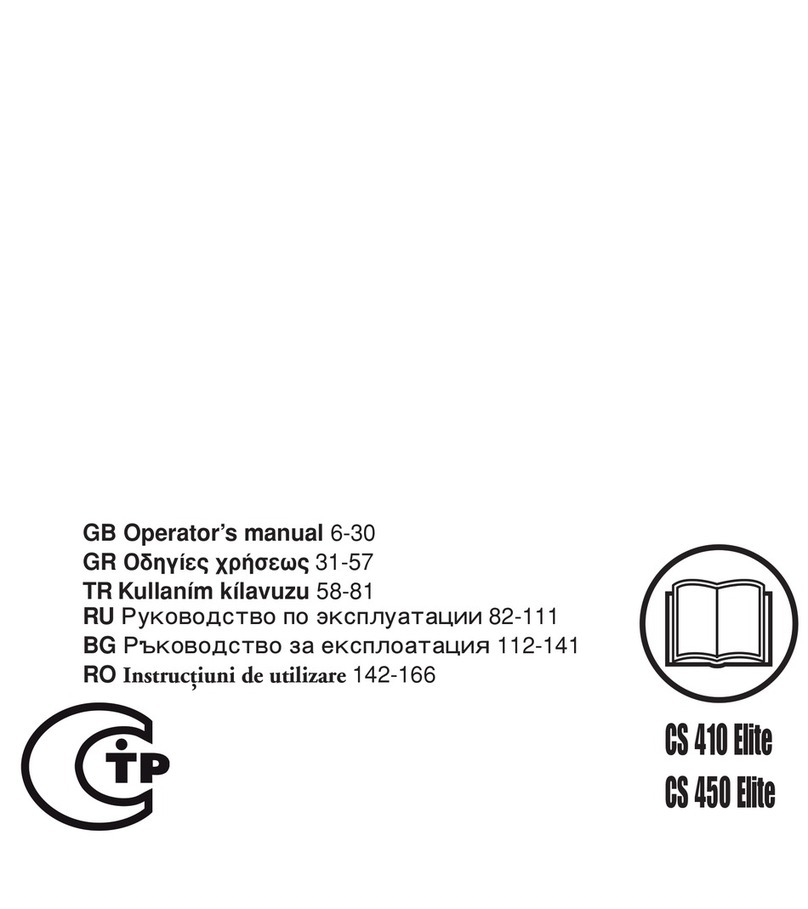
McCulloch
McCulloch Chain Saw Operator's manual
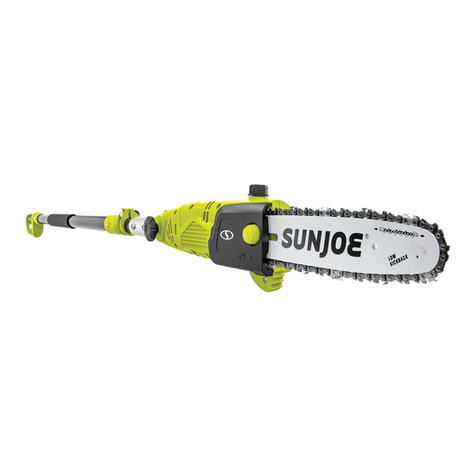
SNOWJOE
SNOWJOE Sunjoe SWJ803E Operator's manual
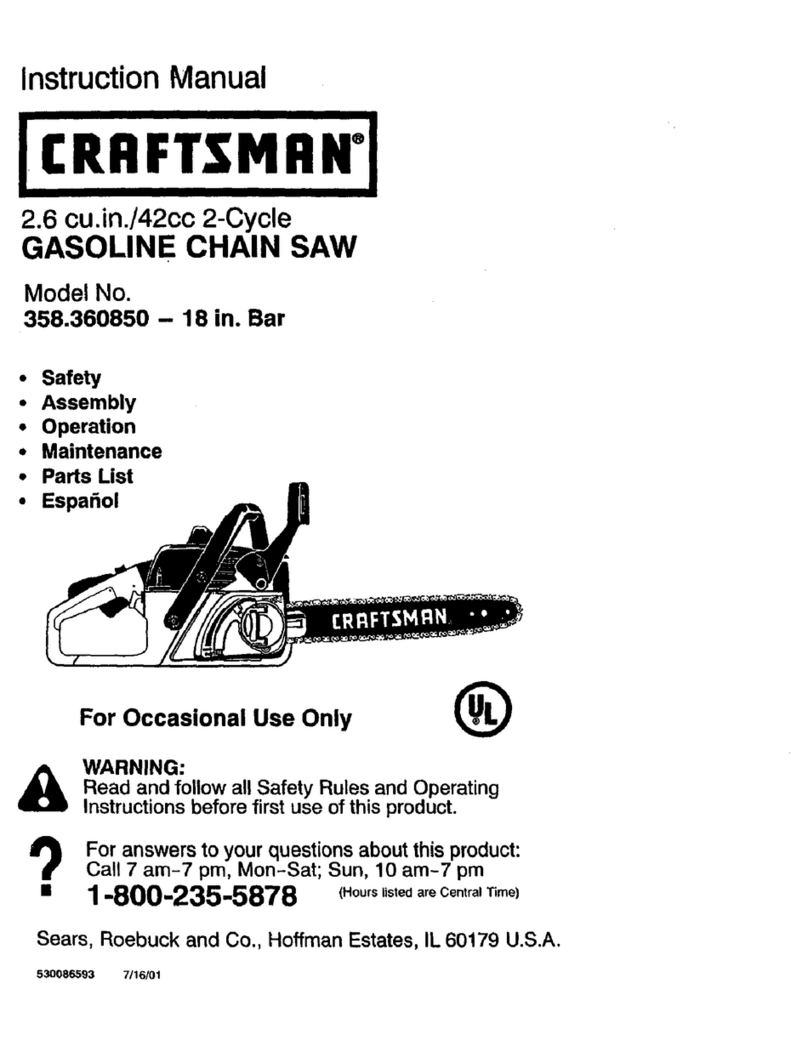
Craftsman
Craftsman 358.360850 instruction manual
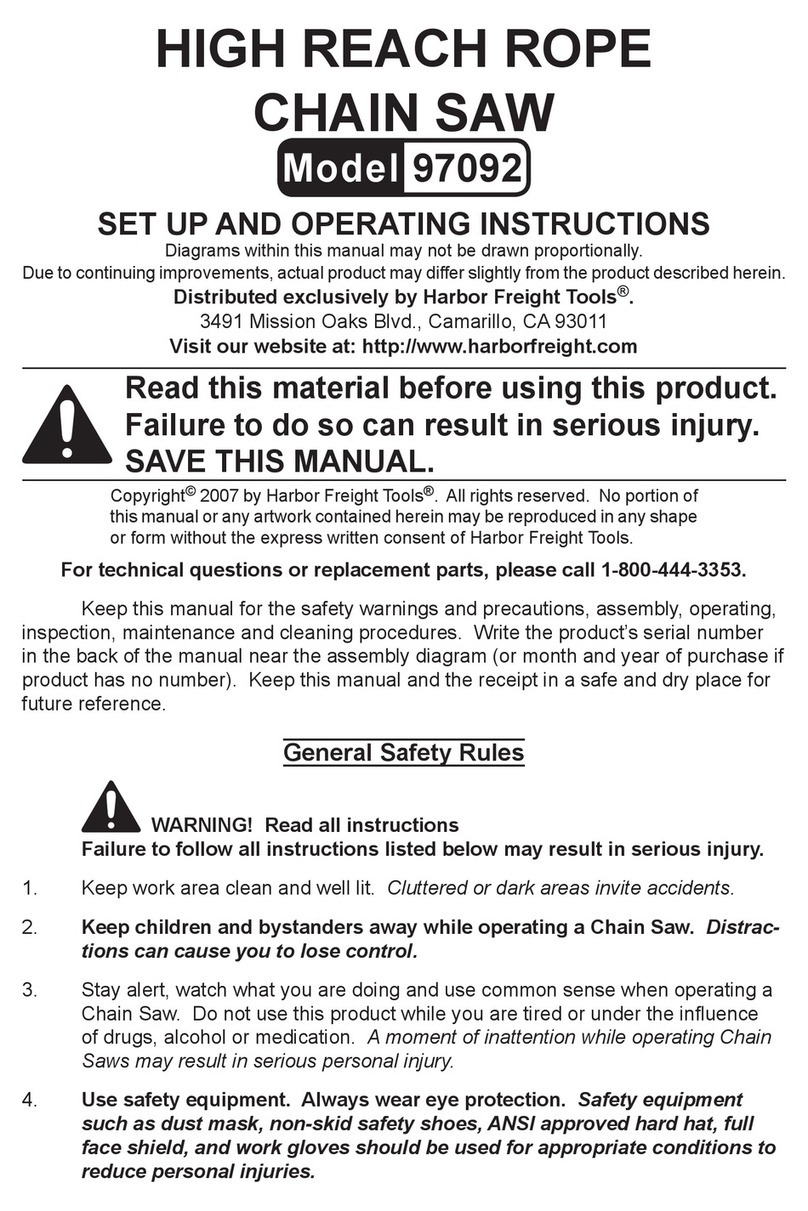
Harbor Freight Tools
Harbor Freight Tools 97092 Set up and operating instructions
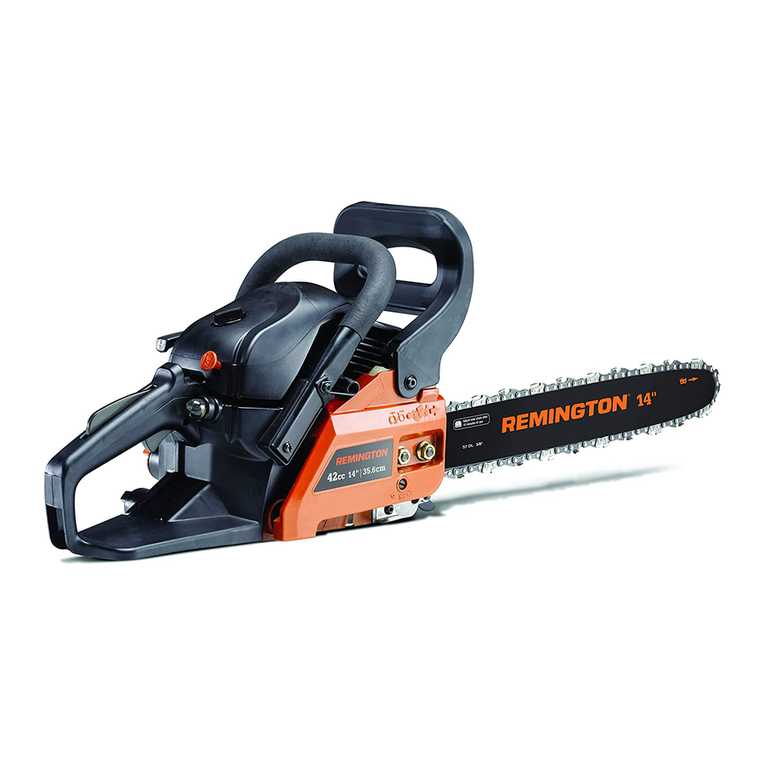
Remington
Remington RM4214CS Operator's manual
